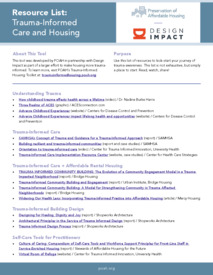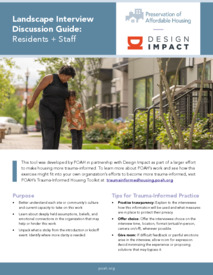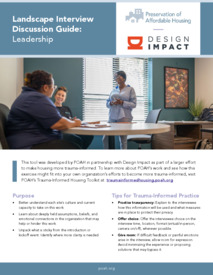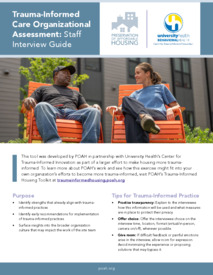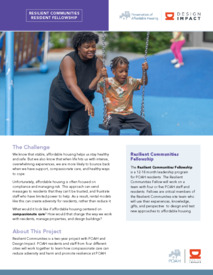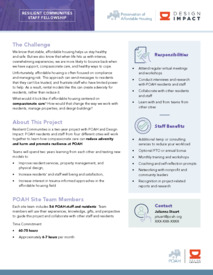-
1Assessment: Where are you now?
Take time to identify where your organization is currently
-
Do your own learning. Use the resources in this toolkit and thisResource Listto help you get started.
-
Talk to a few stakeholders. Have open-ended conversations to learn where you are now and what your community cares about. Download two sample interview guides:
-
Landscape Interview Discussion Guide: Residents & Staff
-
Landscape Interview Discussion Guide: Leadership
-
-
Consider an organizational assessment. A trauma-informed expert like the Center for Trauma Informed Innovation can conduct an organization-wide assessment. Use this simple guide as inspiration:Org Assessment Staff Interview
-
-
2Vision
What’s your “Why”? Why adopt Trauma-Informed Housing? What is your motivation? What do you hope to achieve? Think of this as your project mission. Here are some examples:
-
To advance our organization’s equity goals by recognizing and responding to the way residents and communities have historically been impacted by decisions made without their voice or consent.
-
To help residents be economically mobile by ensuring that efforts to support their financial wellbeing also support their sense of agency and belonging.
-
To retain staff and reduce burnout by developing an organizational culture that supports their agency, belonging, and wellbeing.
-
To stabilize properties by reducing resident turnover and improving lease compliance.
-
To design more durable, beautiful, and functional spaces that enhance staff and resident experience.
-
-
3 Leadership
Support from your organization’s Executive Director or CEO is essential. Build leadership support by identifying how a trauma-informed approach can support your organization’s existing priorities. Select a “quarterback” to manage and champion the project. The quarterback should be empowered to make decisions, adept at building support, and familiar with the organization’s existing operations.
-
4Resources + Incentives
Advancing trauma-informed work can be a relatively low-cost way to drive meaningful change. Here are three things to budget for your project:
-
You will need staff and residents to help you build a trauma informed organization. Honor their labor through payment and give people specific roles. We did so by creating fellowship positions:
-
Resident Fellowship Invitation
-
Staff Fellowship Invitation
-
-
Meals & Transportation: Provide meals or gift cards for virtual meetings and transportation passes for in-person meetings.
-
Project Funds: Set aside some funds to test new trauma-informed ideas.
-
Consultants and partners can help offer expertise, perspective, or just additional implementation support. Read more about the partners we worked with through the Housing Affordability Breakthrough Challenge Grant:
-
Design Impact (consultant, facilitator)
-
MASS Design Group (architect, consultant)
-
The Center for Trauma Informed Innovation at University Health (behavioral health expert, trainer)
-
Stewards of Affordable Housing for the Future (industry expert, convener)
-
Community Services League (supportive service partner)
-
-
-
5Skills
Trauma-informed housing requires an open mind, empathy, and creativity. Here are 4 types of skills that were critical to advancing this process at POAH:
-
Strong meeting design & facilitation. Facilitators create space for collaboration, navigate conflict, engage all participants, ask critical questions, develop creative exercises and can spot opportunities for breakthrough.
-
Data synthesis. Collect qualitative data, identify themes and trends and packaging learning into digestible insights.
-
Knowledge of Trauma-Informed Care. POAH partnered with the Center for Trauma Informed Innovation at University Health to conduct training and offer technical assistance.
-
Technical skills and tools: Miro and Mural are collaboration tools, Zoom and Teams allow virtual meetings and translation services
-
-
6Commitment to inclusion + equity
-
Lived experience is a form of expertise. Value resident and staff perspectives as you would value an academic degree or professional certification.
-
Collaboration at every stage. Trauma-informed is not an outcome, but a way of doing business. Seek diverse perspectives throughout your process.
-
Center the perspectives of those closest to the problem. At POAH this means prioritizing the experience of frontline staff and residents.
-
Here are tactical ways to promote inclusion + equity:
-
Form a core team to set your work’s direction. Invite frontline staff.
-
Build a collaborative work group with staff at all levels and departments to weigh in on your process and strategies.
-
Modify staff schedules and tasks and/or include compensation so staff have time to participate.
-
Go slow. When staff are physically and emotionally burned out, new projects can be exciting but also exhausting. Take your time.
-
Set norms and expectations. Do all participants have access to the Zoom chat? Does this meeting time work best for everyone? Are we advancing the agenda and leaving space for everyone to participate?
-
Compensate residents for their participation. Compensation recognizes a person’s time and expertise as inherently valuable. Sample compensation rates:
-
Membership on a site team: $200/month
-
Participation in an interview: $50/interview
-
Offering an idea for consideration: $15/idea conversation
-
-
-
-
7 Strategy
You will need a plan of action. This toolkit outlines a highly adaptable process for implementing trauma-informed housing in your organization. You can follow the steps in order or revisit steps as needed.
Are you leading your team or organization toward Trauma-Informed Housing? Here are 7 things to consider as you get started:



